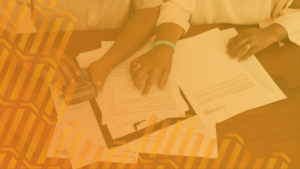How to Ask for Payment in an Email so Customers Reply
September 14, 2021 | Read: 10 minutes

Do you put valuable time and effort into your communications with little to show for it?
When you send important or time-sensitive documents… do you only get crickets in reply?
You’re not alone. Lots of businesses have communication issues that are hurting their cash flow. If that sounds familiar, you might also be wondering if it’s even possible to prevent your emails from going straight to your customers’ trash folders.
Well, we’re pleased to say there is a way:
It doesn’t have to all be trial and error, in fact, there are ways to increase the odds of your invoice emails being opened, paid for, and making their way off of your to-do list.
Read on to find out how!

How to ask for payment in an email—why does it matter?
Okay sure, we’ll admit that on the surface this question is a bit obvious.
These communications matter because you want to get paid, and to do that you need to ask customers to pay you. But how do you ask for payment in an email in a way that ensures your customers will open it and respond?
And why does asking for payment in the email message itself even matter? Shouldn’t the invoice be the main priority?
Not exactly.
Picture this: You just finished a meal at the restaurant you’ve been waiting to try for months. It was great—everything you hoped it would be. As the plates are being removed from the table, your waiter puts out their hand and bluntly says, “We served you, now pay us.”
It’s kind of jarring, right? And the same goes for your customers. Whether you’ve just installed that HVAC unit they’ve been saving up for, or set up those security cameras to help put them at ease, it won’t leave a great impression if you send an invoice with no further explanation.
Invoices are a part of their customer journey, and to ensure repeat business, it’s not a place you want to drop the ball.
Furthermore, if the message is vague, unclear, or indirect you risk the chance of customers ignoring your emails or putting payments off. This only results in more follow-up work on your end—and do you really want to add another phone call or email to your calendar?
Ultimately, the message of your invoice email matters because it’s an opportunity to show your customers you value them—and valued customers can easily become loyal ones. It’s a chance to build a relationship with them rather than make it seem like this was a one-time transaction.
Keep in mind, it can cost 10x more to win new customers than it does to keep an existing one—and those repeat clients will spend, on average, 67% more! Are you feeling the pressure to create some rock-star invoice emails now? Don’t worry, we’ve got plenty of tips below to help!
Subject lines are a big deal
How many times has an email notification popped up on your phone, you glanced at the subject line, deemed it unworthy of your time, and quickly swiped it away so you could proceed with your busy schedule?
Your customers are human too, and more than likely also guilty of this behavior. With so many people trying to get in touch with us on a daily basis, it can be difficult to stand out. But if you want to dodge that dreaded swipe and avoid the trash folder, it’s time to up your subject line game.
First and foremost, it’s important to clarify to your customer’s judging eye that your email is important. If your subject line doesn’t stand out and warrant a click, your cash flow is going to be at risk. Customers can’t send back a document they haven’t seen, so your primary goal should be to ensure they open your communications. When asking for payment in an email, the message shouldn’t be easily confused as spam or something that can be put off for a later date and time.
To do this, we (highly) recommend putting the word “invoice” within the subject line. Don’t make it vague, make it direct. Avoid titles that sound like phishing, i.e. “Your payment is due.” Instead, consider including your company’s name so your customers can easily identify who the invoice is from.
It sounds straightforward, but when clients are moving from one task to another and casually checking their phones in between, they are not hyper-focused. In fact, 35% of emails are opened based on their subject lines alone—so don’t give customers the opportunity to mistake your invoice email as junk mail. Otherwise, it’s your field service business that will pay the consequences.
3 things to include when you ask for payment in an email
Now that your subject line is the best thing since sliced bread, let’s focus on how you should ask for payment in an email message. As mentioned, this is not the place to be blunt or impersonal. Your message is an opportunity to create an even better experience for your customers, one that’s so awesome it leaves them with no hesitations to use your services again.
So, let’s break it down. There are three things your invoice email will need:
1. A thank you
Seriously. Thank your customers for the opportunity—it can go a long way. They might have spent hours evaluating providers and gathering quotes before deciding on your services. Maybe they even took the day off of work to be home when you arrived for the job. Acknowledging their time and effort is equally as important as recognizing yours.
Of course, we’re not looking for anything over the top here. It’s best to keep it sincere and simple, and in most cases early on in your message. They could have chosen a different provider for the job but they went with your business, so ensure they feel like a valued customer to build trust and loyalty.
2. Personalization
A great way to think about how to ask for payment in an email is to frame it as a conversation. You want your customers to respond to your communications, and when we have discussions with people they tend to be personal. We use their first names and details that are specific to them. The same should stand true in your email messages.
In fact, 62% of people said they felt “happy” to respond to an email that was personalized to them. So, if you want to increase your reply rates, it’s time to get personal.
Granted, this sounds like a lot of work. Typing up details into each invoice email seems like a good chunk of time and effort—which ideally we’re looking to reduce. And the good news is you can! The secret lies in a great customer database software.
If you keep all of your customer data in one central place, you can simply add personalization tags to your email templates that will auto-populate when writing to customers. This way you can tailor the messages to them—increasing the chances of a response—with minimal work on your part.
3. Make it easy for customers to pay
Again, this might scream obvious, but it tends to be a real issue for many field service businesses when asking for payment in an email. You might have the most outstanding email message, but if your customers can’t easily find a way to pay, it will become a major roadblock.
Attaching the invoice to the email is a great first step, but you also need to include the ways you’ll accept payment:
- Do they need to mail a check? (And if so, did you provide the address where they should send it to?)
- Can they pay in cash?
- How much time do they have to get it to you?
- What if they want to pay online, is an online payment portal an option? (If yes, did you include the link for them to follow?)
Leaving this information out is a gateway to delayed payments, and as a result a lot more follow up and chasing for you. Don’t give customers easy reasons to put off paying their invoices. All of the options and the terms and conditions should be clearly laid out within the email message.
Read More: Integrating Instant Bank Pay Into Your Maintenance Business
What should you do when emails don’t work?
The unfortunate reality is there will always be a small handful of customers who, for whatever reason, refuse to pay. You sent them your best email asking for payment, followed up with a phone call, and heard nothing back but those dreaded crickets. What should you do next?
It’s time for the past due email.
We recommend keeping these messages straightforward and polite. Respond to your original email with the new message so the customer can clearly see the date stamps between the communications. For example, if you gave them a 14 day deadline to pay the invoice and it’s now day 15, that will all be recorded within the emails.
Next, try to stay optimistic. Life happens, maybe there is a genuinely valid reason your customer hasn’t responded yet. Keep the tone of your message direct but also friendly, and consider asking them if there’s anything else they need from you or, if the previous communications were unclear. Remember, emails are conversations, so asking questions will always help to encourage a response.
If it’s still radio silence from them, it might be time to seek legal advice.
While we can’t emphasize enough the importance of creating great customer journeys and experiences, they shouldn’t come at the cost of your field service business’ revenue. You team did a great job and deserve their compensation.
It may feel uncomfortable chasing a debt, but if you waive too many outstanding invoices it will eventually catch up to you and impact cash flow. If this is a frequent challenge that you find yourself up against, here are some additional tips on steps you can take when customers refuse to pay for work done.
How to ask for payment in an email
How to ask for payment in an email can feel uncertain, there’s no doubt about it.
There’s a fine balance between being direct in your request while also working to create a great customer journey.
As in every relationship, your customers’ needs and your own are equally important, so make sure you’re prioritizing both.
A great invoice email will be clear, friendly in tone, and straightforward for your customers to send back payment. But if you’re still feeling unsure on how to ask for payment in an email, we’ve got you covered.
Check out our guide and get the perfect invoice email template below!









